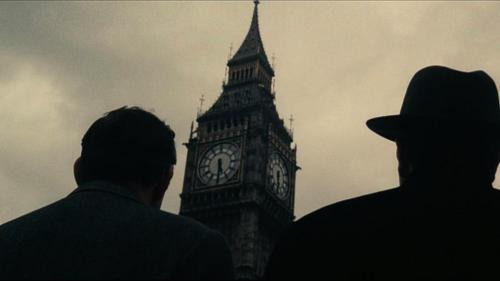Hard work never betrays: Marclay's media art at Leeum
이 글자크기로 변경됩니다.
(예시) 가장 빠른 뉴스가 있고 다양한 정보, 쌍방향 소통이 숨쉬는 다음뉴스를 만나보세요. 다음뉴스는 국내외 주요이슈와 실시간 속보, 문화생활 및 다양한 분야의 뉴스를 입체적으로 전달하고 있습니다.
Watching Christian Marclay's media art "Clock" is an overwhelming experience for three reasons: One, you could never count how many films, watches or clocks are in it; two, you could easily get confused about whether the world inside or outside the screen is reality; and three, no one, at least in Korea, could ever see the whole thing.
The 24-hour-long exhibit is a collage of excerpts featuring clocks or watches from approximately 3,000 to 5,000 films. What is even more astounding than the artist going through such time-consuming work is that it is showcased in real-time. Meaning, if the clock in the work reads 12:43 p.m., it is 12:43 p.m. in the world in which you stand.
How on earth did he do it?
"I had assistants who had the best job in the world ― they just had to sit there and watch films and bring me excerpts I was interested in. I just edited it," the U.S. artist told the press at Leeum, Samsung Museum of Arts on Monday.
He made it sound so simple but the editing alone took 28 months and the whole process took a good five years.
"Clock" and two more of Marclay's impressive media works are on display at the exhibition "Christian Marclay: What You See Is What You Hear" which kicked off on Thursday at Leeum's Black Box in Hannam-dong, central Seoul.
|
|
A scene from "Clock" by Christian Marclay (Christian Marclay, courtesy of White Cube) |
It is the museum's first "Black Box Project" which aims to introduce world-renowned media artists to the Korean public. Black Box is a giant concrete black box designed by architect Rem Koolhaas, fixed to float 17 meters above the floor inside the museum.
Sitting in front of the screen viewing "Clock," glancing back and forth between a watch and the screen to see if the time really accords and trying to spot familiar scenes, time really flies by. No wonder a group of visitors at White Cube Gallery in London, where it premiered in October, spent a full day watching it.
"It ('Clock') was labor intensive, but in the end, it is not important. Viewers should not think about the labor when they see the work. They should just be aware of the time they are in and the way they perceive images," said Marclay.
Though he is not well-known here, Marclay is an established artist in Europe and the U.S. whose contemporary artworks are frequently seen in prestigious biennales. He is especially interested in sounds. Using various media he ponders the question: How we can hear what we see? Like music, "Clock" articulates dynamics itself, pulling in the viewers. It gets intense as it gets close to every hour, especially midnight as Marclay said he had so much material for that time he could count up by the second. It becomes more relaxed afterward.
Several Korean movies appear in the work as well, including a scene from "I'm a Cyborg but That's Ok" where actress Lim Soo-jung hides behind a wall clock displaying 2:30 p.m. and a scene from "Old Boy" when Choi Min-sik looks at the watch that reads 3:20 p.m.
Unfortunately though, Leeum does not open its doors 24 hours a day so museum-goers will not be granted a full day of "Clock" as visitors to the White Cube were.
The other two showcased media works are collages too. The seven minute-long "Telephone" consists of movie scenes that involve phones ringing, people dialing, talking or hanging up, and the 14 minute-long "Video Quartet" displays film excerpts of musical or noisy moments like singing, playing instruments, screaming or breaking things in four different screens.
"It (Collage) is reinterpreting what's around me. Instead of being a passive viewer, I get involved. I don't like to create from nothing and invent the world, I more like to react to the world," he said.
"My collages are more like 'quotations.' In legal terms, they should be something like 'fair use.' There have been no (legal) problems since 1995 when I started these works and I hope there will not be in Korea," he said, jokingly.
The exhibition runs through Feb. 13 at Leeum, Samsung Museum of Art in Hannam-dong, central Seoul. Tickets are 2,000 for students and 3,000 won for adults. A day pass which includes all permanent and special exhibitions underway costs 8,000 won for students and 14,000 won for adults. For more information, call (02) 2014-6901 or visit www.leeum.org.
By Park Min-young ( claire@heraldm.com)
Copyright © 코리아헤럴드. 무단전재 및 재배포 금지.
